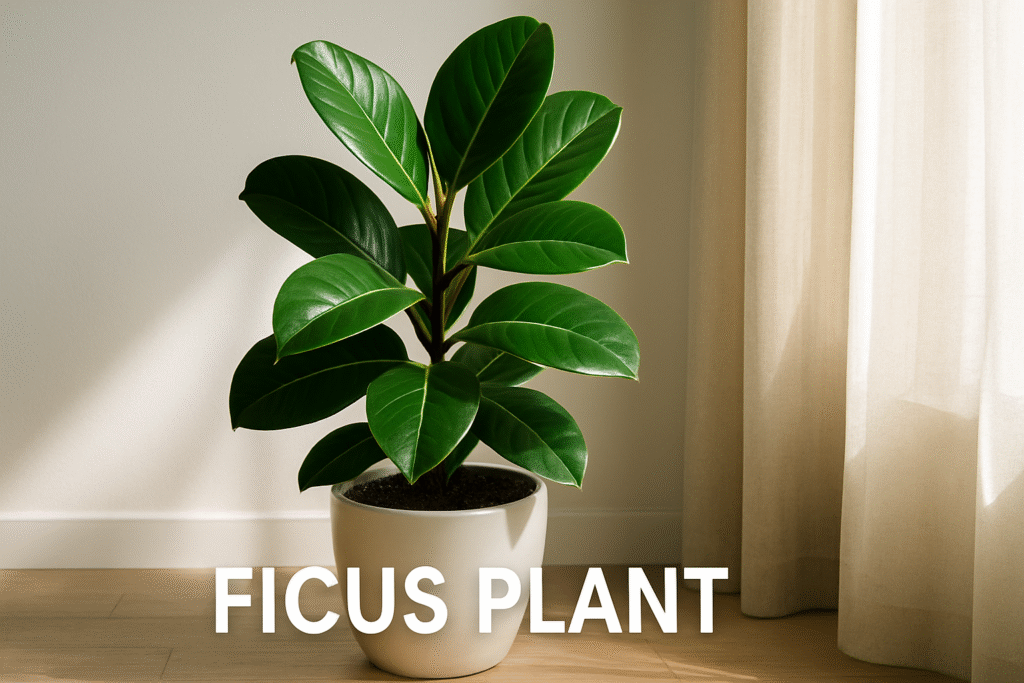The Ficus plant is one of the most popular ornamental plants grown both indoors and outdoors. It belongs to the Moraceae family, which includes more than 800 species. Known for its lush green foliage, easy adaptability, and elegant appearance, the ficus plant is a favorite among plant enthusiasts, interior designers, and gardeners. Whether you choose it as a decorative indoor plant or a shade-giving outdoor tree, the ficus plant adds natural beauty and freshness to any environment.
Introduction
Ficus plants are evergreen trees and shrubs found in tropical and subtropical regions around the world. They are native to parts of Asia, Africa, and Australia but have been cultivated globally due to their versatility and aesthetic appeal. The ficus plant is valued for its glossy leaves, attractive shapes, and air-purifying abilities.
From compact indoor species like Ficus elastica (Rubber Plant) to tall outdoor varieties like Ficus religiosa (Peepal Tree), there is a ficus for every kind of gardener. The wide range of species makes it easy to choose one suitable for homes, offices, or gardens.
History and Background
The ficus genus has a deep historical and cultural significance. Many species of ficus trees, especially Ficus religiosa, have been revered since ancient times. In several Asian cultures, the ficus tree symbolizes peace, prosperity, and spiritual enlightenment. The “Bodhi Tree” under which Buddha attained enlightenment was a sacred fig, a member of the ficus family.
Over time, various ficus species were introduced to other continents for ornamental and agricultural use. Their adaptability to diverse climates and ease of growth made them a popular choice for both landscapes and indoor decoration.
Common Types of Ficus Plant
There are hundreds of ficus species, but the following are the most popular ones grown worldwide:
Ficus elastica (Rubber Plant)
This is one of the most common houseplants. It features large, thick, glossy leaves that can grow in different shades of green, burgundy, or variegated patterns. It thrives in indirect light and adds a tropical touch to interiors.
Ficus lyrata (Fiddle Leaf Fig)
Known for its large, violin-shaped leaves, this variety is a top choice for modern home decor. It prefers bright, indirect light and moderate watering. Although it can be slightly finicky, the dramatic look makes it worth the effort.
Ficus benjamina (Weeping Fig)
A graceful plant with slender branches and glossy leaves that often droop, giving it a weeping appearance. It can grow tall indoors and is ideal for offices and living rooms.
Ficus microcarpa (Indian Laurel Fig)
Often grown as a bonsai, this ficus variety has a thick trunk and dense foliage. It is hardy and can tolerate frequent pruning, making it perfect for shaping into decorative forms.
Ficus religiosa (Sacred Fig or Peepal Tree)
A large outdoor tree native to India and Southeast Asia, this ficus species has heart-shaped leaves and is often planted near temples due to its spiritual significance.
Ficus carica (Common Fig Tree)
This species is cultivated for its delicious, edible fruits known as figs. It grows best in warm, dry climates and can reach considerable heights when planted outdoors
Ideal Growing Conditions

Light
Ficus plants grow best in bright, indirect light. Direct sunlight can burn their leaves, while low light can slow growth and cause leaf drop. Placing the plant near a window with filtered sunlight usually provides the best conditions.
Temperature
They prefer temperatures between 18°C and 27°C (65°F to 80°F). Avoid placing them near air conditioners or heaters, as sudden temperature changes can stress the plant and cause leaf shedding.
Humidity
Most ficus plants prefer moderate to high humidity. Indoor air can often be dry, especially in winter, so misting the leaves or using a humidifier helps maintain the right moisture level.
Soil
A well-draining soil mix is essential. A combination of peat moss, perlite, and loam works best. Avoid heavy soils that retain excess water, as this can lead to root rot.
Water
Water only when the top inch of soil feels dry. Overwatering is a common mistake that leads to yellowing leaves and root problems. Reduce watering during the winter months when the plant’s growth slows.
Fertilization
During the active growing seasons (spring and summer), feed the ficus plant every 4–6 weeks with a balanced, water-soluble fertilizer. This ensures healthy foliage and steady growth. Stop fertilizing during the colder months when the plant goes dormant.
Pruning and Maintenance
Pruning helps ficus plants maintain their shape and promotes new growth. Trim away dead or diseased leaves and branches using sterilized scissors. You can also prune back leggy stems to encourage bushier growth.
Wipe the leaves occasionally with a damp cloth to remove dust, as clean leaves absorb light more efficiently. Regular maintenance keeps the plant healthy and attractive.
Propagation
Ficus plants can be easily propagated through stem cuttings. Here’s how you can do it:
- Select a healthy stem about 6 inches long with a few leaves.
- Cut just below a node using a sharp, clean blade.
- Dip the cut end in rooting hormone to speed up root development.
- Place the cutting in a small pot filled with moist potting soil.
- Cover the pot with plastic wrap or a plastic bag to retain humidity.
- Place it in bright, indirect light.
Roots typically appear within 4–6 weeks. Once established, the new plant can be transplanted into a larger pot.
Common Problems and Solutions

Leaf Drop
One of the most frequent issues with ficus plants. It often happens due to sudden changes in light or temperature. To fix it, keep the plant in a stable environment and avoid moving it frequently.
Yellow Leaves
This usually indicates overwatering or poor drainage. Let the soil dry slightly before watering again and ensure that the pot has proper drainage holes.
Brown Tips on Leaves
Brown leaf tips are a sign of low humidity or excessive fertilizer. Increase humidity around the plant and reduce feeding frequency.
Pests
Ficus plants can attract pests like spider mites, aphids, and mealybugs. Regularly inspect the leaves and treat infestations with neem oil or insecticidal soap.
Repotting
Repot your ficus plant every two to three years or when you notice roots coming out of the drainage holes. Choose a slightly larger pot and use fresh potting mix. Repotting provides more room for root growth and ensures healthy development.
Outdoor Ficus Care
Outdoor ficus trees grow best in warm climates where temperatures do not drop below freezing.
Here are a few tips for outdoor growth:
- Plant in well-draining soil with partial shade.
- Water regularly, especially during dry months.
- Prune to maintain shape and prevent roots from spreading too aggressively.
- Apply mulch around the base to retain soil moisture.
Note that outdoor ficus trees can develop large, invasive root systems, so plant them away from buildings or underground pipes.
Benefits of Ficus Plant
- Air Purification: Ficus plants help remove toxins from the air, improving indoor air quality.
- Stress Relief: Studies suggest that having indoor plants like ficus can reduce stress and enhance mood.
- Aesthetic Appeal: Their glossy leaves and rich green color make them a perfect natural décor element.
- Environmental Role: Outdoor ficus trees provide shade, reduce heat, and support birdlife.
- Spiritual Value: In many cultures, ficus symbolizes growth, strength, and wisdom.

Seasonal Care Tips
Spring
The growing season begins. Start fertilizing and pruning to promote new leaves.
Summer
Water regularly and protect from harsh direct sunlight. Mist leaves to maintain humidity.
Autumn
Gradually reduce watering and remove any dead leaves.
Winter
Keep the plant warm and avoid overwatering. Move it away from cold drafts or frosty windows.
Expert Tips for Healthy Growth
- Rotate your ficus plant every few weeks so all sides receive equal light.
- Avoid moving the plant too often; ficus plants dislike sudden changes.
- Clean the leaves to allow better photosynthesis.
- Use filtered water if your tap water contains high chlorine levels.
- Do not over-fertilize — too many nutrients can harm the roots.
Indoor Styling Ideas
Ficus plants blend beautifully with different interior styles. A tall Ficus lyrata in a ceramic pot looks stunning in modern living rooms, while Ficus elastica pairs well with rustic and boho settings. Small ficus varieties can be placed on desks or shelves to add greenery to workspaces.
Environmental Impact
Apart from being visually appealing, ficus trees play a vital role in the ecosystem. They provide shade, prevent soil erosion, and act as natural carbon absorbers. Birds and insects also rely on ficus fruits and flowers for nourishment, making these plants important contributors to biodiversity.
Frequently Asked Questions
What makes the Ficus plant unique?
Its versatility, range of species, and adaptability to indoor and outdoor environments make it unique.
How often should I water my Ficus plant?
Water once the top layer of soil dries out. Frequency varies with season and indoor humidity levels.
Can ficus survive in low light?
Some species can tolerate low light, but most prefer bright, indirect light for healthy growth.
Why is my ficus dropping leaves?
This can happen when you move it suddenly or expose it to drafts or temperature changes.
Are ficus plants toxic?
Yes, ficus plants contain a milky sap that can irritate skin and is toxic to pets if ingested.
Conclusion
The Ficus plant is a timeless favorite for gardeners and plant lovers worldwide. It combines beauty, resilience, and environmental value. With proper care—balanced watering, bright indirect light, and occasional pruning—your ficus can thrive for many years.
Whether you choose it as a statement indoor plant or a majestic outdoor tree, the ficus plant symbolizes growth, tranquility, and connection with nature. It’s not just a plant; it’s a living expression of greenery and peace that brings vitality to any space.

